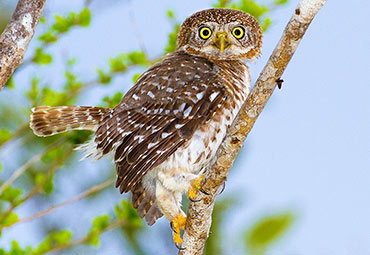We chose Sijú for our mascot and logo for Legal Cuba Travel because she’s wise and a survivor – traits needed to navigate the ever-changing legal and political relations between the United States and Cuba.

Smart and endearing, learn about the Cuban pygmy owl
‘Sijú platanero’ a Cuban endemic owl
Meet our mascot Sijú (pronounced see-WHO). She’s a Cuban pygmy owl and the logo for Legal Cuba Travel. Her genus is Glaucidium siju. Cubans call her sijú platanero. She’s endemic to Cuba, but some of her family have migrated to nearby Caribbean islands. How Cuban is that?
Cuban pygmy owl is the smallest owl in the Caribbean
Plus, Sijú is cute! She is about the size of a robin. Her colors are urban and rural camouflage chic – hands-down high fashion. Her head is orange, and her sides and back brown cinnamon with white highlights on her tummy. Her dramatic eyebrows are whitish. She wears dark Arabic eyeliner that features big bright yellow to orangish eyes, and she sports a perky white striped tail.
Sijú’s future seems safe, but she’s an exception among her Cuban feathered friends, many whose status is endangered because of habitat loss and poaching.
Resilient and versatile, future hopeful for Cuban pygmy owls
Pygmy owls have adapted to limited island resources by down-sizing – just like many Americans who live from paycheck to paycheck. Cuban pygmy owls are about the size of a robin, weighing in at three ounces, and only six inches from beak to tail. Many other old and new world owls with space to grow are twenty times larger in all dimensions.
Sijú is unflappable and tenacious. She communicates with her fellows issuing a charming whistle-like chirp: “jiu,” and repeats it: “jiu, jiu, jiu, jiu,” beginning softly and increasing in volume over fifteen seconds.
Her breakfast, lunch, and dinner consist of baby lizards, baby frogs, baby rodents, insects, and small birds. Sijú is a voracious carnivore, as are most Cubans.
She stocks prey from branches close to her nest and stealthily swoops down on unsuspecting meals wandering below, capturing them in her sharp talon’s death grip. Despite her vulnerable size, she shows little fear, even from approaching humans.
Struggling moms do all the work, but get all the credit
Sijú renews her family (after finding a willing mate) every dry season during Cuba’s winter months. She lays three to four eggs. She incubates them, oversees hatching, feeds, and teaches them. The jury is out on what her mate is up to during this time, or in general.
She is smart and efficient, utilizing abandoned nests of other birds or making one in naturally occurring tree holes. Her broad range of nesting grounds includes coastal areas, mountains, forests of all types, and agricultural lands attest to her resourcefulness.
She works both day and night, like so many moms, to find food for her family. She employs a cunning disguise to thwart enemies: she sports two false eyes on the back of her head to deter attacks by larger owl species, hawks, and crocodiles!
Her legs are feathered because it gets cold in Cuban mountain tops – as low as 42 degrees Fahrenheit during December, January, and February.
The vast range of the Cuba pygmy owl promises you’ll come across one of these birds when you’re traveling through the lush Cuban countryside.
Are you a birdwatcher, ornithologist, and nature lover?
Interested in bird spotting in Cuba? We offer unique private programs and public tours for ornithophiles. The island is home to 397 species, of which 30 hold vulnerable to critically endangered status. Cuba has 27 endemic birds, native to Cuba, and found nowhere else. There are 14 species considered near-endemic. Check out our popular Cuba birds and culture safari, recognized as the most fun, comprehensive, and affordable Caribbean birdwatching trek available. Learn more about Cuba’s rare and native birds here.






